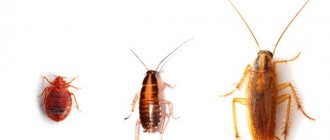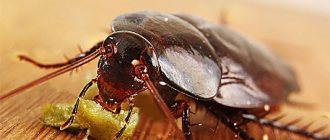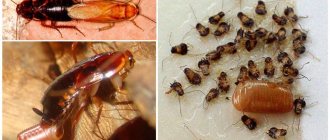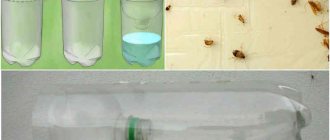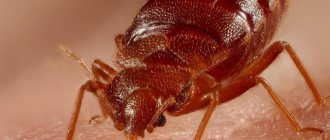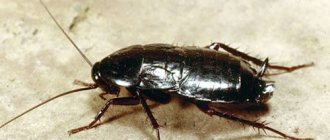Red cockroaches are among the most common parasites that live in apartments and private houses. Pests greatly annoy apartment owners; they have become so commonplace that they have acquired a lot of funny nicknames.
Stasik, Prusak, Felix, Tarasik. And the list is not complete. Why are cockroaches called stasis, what other names are used to refer to parasites - let's try to figure it out.
Marine version
It has long been ingrained in the minds of most people that the words cockroach and stasik are synonymous. There are many versions of awarding the Prussians with an affectionate and euphonious nickname, but the most common is called the sea one.
The reason is maritime and prison folklore, and this version, by the way, is confirmed by historical facts.
So, prisoners and sailors often called the widespread pubic lice a strong curse word. It was generally accepted that the causes of this infection were people of non-traditional sexual orientation, for whom harsh obscene words were used.
Over time, the use of swear words was considered unethical . And the strong curse word was replaced with the softer-sounding word “stas.” Many call cockroaches this way to this day. The diminutive nickname “stasik” is also used.
Cockroach reproduction rate
Knowing with what frequency and in what way domestic cockroaches give birth to offspring, you can prevent their reproduction and, over time, eradicate all these insects. Since apartments have the most comfortable conditions for their existence, cockroaches can reproduce throughout the year, and they do this almost with lightning speed.
In more than four months, their numbers can increase several times, with thousands of new individuals counting. This is due to the fact that all cockroaches, without exception, are capable of laying eggs, because they are representatives of both sexes, and in one clutch there are usually over sixty insects.
Both male and female cockroaches will lay approximately 22 capsule-like eggs during their lifetime. Less commonly, cockroaches reproduce in the traditional way - by copulating with each other.
Mustached version
It can be explained why cockroaches are called stasikas: the nickname was attached to the insects in connection with the most important feature - the mustache.
There are two versions:
- In pre-revolutionary times, the male name Stanislav was popular in noble families. The bearers of this name had a thick, lush mustache, which was carefully maintained. In addition, the people noted the craftiness and mobility of the Stanislavs, and since cockroaches run quickly, a line of correspondence was drawn between the nimble men and the insects.
- The second version is as follows: previously it was believed that the Stanislavs had a thick mustache. And if they had a red color and a characteristic curl, such men looked like insects.
According to the above versions, the diminutive nickname “stasik” was chosen due to their nimbleness, long mustache and small size.
Similarities to men named Stanislav
In past centuries, the male name Stanislav (short form - Stas) was very common. According to people’s observations, the owners of this name and the “cockroaches” had a lot in common:
Presence of a mustache. Fashion for facial hair appears cyclically. Long, curled mustaches used to be a trend. They were looked after and starched. It is believed that it was the Stanislavs who had a weakness for wearing a mustache. Most of them were red. Everyone knows what cockroaches look like. Their characteristic feature is their long mustache. Perhaps it was this common feature that led to the fact that insects began to be called stasiks.
Anecdotal version
On the territory of the Soviet Union, the anecdote about a gray wolf suffering from a hangover, past whom a red cockroach, whose name sounded none other than Stasik, had the imprudence to run past was quite popular. The forest orderly, due to his own poor health, swatted the insect, supplying the movement with the phrase “if only you knew how bad I feel, Stasik.”
The above version can hardly be considered reliable, since the anecdote was distributed only in Russia . However, the nickname stasik has long been used to identify cockroaches in Ukraine, Belarus and other neighboring countries. However, this hypothesis also has a relative right to exist.
The funny thing is that if this option is true, then the choice of the name of the insect by the joke writer would determine how the mustachioed pests would be called in the future.
That is, if the author of the funny cockroach story had called Fedenka or Mishenka, these are the names that would have been in use to this day. It is difficult to imagine that insects that cause harm to households are called differently, however, the phrase stasik has not previously been mentioned to define parasites.
Interesting nicknames for cockroaches: Stasik, Tarasik, Prusak
All animals - friends, helpers and enemies - have scientific names and popular nicknames. Sometimes it is very difficult to guess the origin of these words. For example, why are cockroaches called “stasiks” or “tarasiks”?
These nicknames are common over a large area, but are used mainly in colloquial speech. An explanation of the popular names of a harmful insect will help to better understand the population’s attitude towards it.
The main versions of the origin of the nickname “stasik”
A philologist could offer a simple interpretation: the humorous colloquial name “tarasiki” came from the word “cockroaches”, and from it “stasiki”.
Another version belongs to experts in urban folklore. Instead of the words “go to the toilet” they sometimes say “go to Stas”. The name suited the small insects that have taken a liking to bathrooms.
Anecdote about the wolf and Stasik
There was no shortage of nicknames, but not all of them stuck in memory. The name “stasika” could have been preserved thanks to an anecdote.
“The wolf is suffering from a severe hangover, holding his head and moaning. He notices a cheerful cockroach running past. Barely moving his tongue, he asks:
- Who are you?
The new acquaintance gallantly introduces himself:
- Stasik, cockroach.
The wolf slams the beetle with his paw with all his anger and howls:
“I feel so bad, Stasik!”
Red cockroach
Also read - Where did the cockroaches go: the main reasons for the disappearance of cockroaches from our homes
If anyone doesn’t already know, “stasiks” are cockroaches, photos of which can be seen on the website. At first glance, the long antennae on the front of the head attract attention.
Doubles version
The presence of luxurious mustaches on cockroaches can explain the possibility of applying to them the nickname not only Stasik, but Felix. It's easy to explain. As you know, Felix Edmundovich Dzerzhinsky, a security officer in the Russian post-revolutionary space, had amazingly luxurious, rich facial hair.
People who are keen on nicknames, including offensive ones, quickly noted this outstanding feature and began calling nasty indoor parasites by the name Felix.
What are other names for cockroaches in different countries?
Cockroaches, as mentioned above, are the most common parasites. Even the ubiquitous blood-sucking bedbugs appear in homes much less frequently. It is precisely because of this prevalence that people use a lot of different names, each of which is funnier than the other.
The most popular ones:
- Felix. One of the popular nicknames reflects the mood of the people of the post-revolutionary space. The generally hated security officer Dzerzhinsky had a luxurious thick mustache, which did not go unnoticed. It is thanks to him that parasites are still called felixes.
- Prusak. The massive appearance of pests in the territories of villages and cities of the Russian state began during the invasion of their territories by Napoleon’s troops, that is, Prussian troops, this is what determines the name of the parasites. It is difficult to say whether it was the French soldiers who actually caused the massive spread of insects, but the fact remains. Before Bonaparte's invasion, there were no cockroaches in the Russian Empire.
- Russian. The following fact is also interesting: the massive appearance of insects on French territory also coincided with the time of penetration of Russian troops, that is, the French believe that the cause of the appearance of parasites was Russian soldiers. Scientists suggest that this phenomenon is actually explained as follows: periods of war simply coincided with periods of rapid increase in the population of red cockroaches, which are distinguished by their tenacity and are distributed everywhere.
- Tarasiki. The aristocratic and noble name for cockroaches, Stas, simply did not take root in the everyday life of ordinary people; the name Tarasik, which was easier to remember, came along. By the way, this nickname is still used to refer to people who are not neat and tidy.
- Trams, tanks, cars. These names are still used in everyday life; it is easy to explain such interesting names. The given nicknames have some similarity in sound with the word cockroaches. In addition, the speed of movement of parasites is important.
- Ryzhiki or Shuriki. The given nicknames explain the external color of the red parasites. These names were more often used in the Soviet Union, but they still enjoy considerable popularity to this day.
- Zhivchiki. The name is popular, but its origin is unknown.
So, the reasons for the appearance of funny names were discussed above .
It’s easy to explain why they have taken root among the people - it’s much easier to call unpleasant red-haired parasites using abbreviated funny phrases.
Why are red cockroaches called “Prussians” and is it possible to get rid of them?
They are hated and feared. It is very difficult to get rid of them.
Misconception #1. We have always lived in Rus'.
Indeed, sometimes it seems that cockroaches have always lived next to humans, but this is only partly true. For example, in Russia until the 18th century they did not know about cockroaches. But, thanks to their habit of hiding behind collars and in the folds of clothing, this omission was corrected. So, presumably, the Russian soldiers who fought against Frederick’s army, in addition to victories, also brought cockroaches with them. Since then, the name “Prussians” has been assigned to red cockroaches. It is difficult to say how historically reliable this is, but until that time no cockroaches had been seen either in Moscow or St. Petersburg.
We also have black and American cockroaches. Moreover, the latter appeared only in the 20s of the last century.
Misconception No. 2. Without bad habbits.
It turns out not. This creature, almost perfect from the point of view of evolution, is also a slave to its habits. For example, it has long been a known fact that Prussians are partial to beer, the smell of which often forces them to check empty beer bottles and cans and... choke on the remains of the treat. A cockroach moving its whiskers is a common phenomenon. Previously, it was assumed that Prussians touched objects with their whiskers and thus received information about the world around them. In fact, they not only touch objects, but also smell them with their whiskers. True, a cockroach still cannot breathe through such a nose, so the version of the old joke that without a mustache a cockroach will suffocate is far from reality.
Misconception #3. There are no teeth in the stomach.
This is true for anyone, but not for cockroaches. As it turns out, cockroaches chew not only with their jaws, their stomachs are also equipped with teeth and strong muscles. The diet of cockroaches is also incredibly wide. Prussians have been spotted eating foam rubber, polystyrene foam and some types of plastics. Moreover, an adult cockroach is able to carry away and eat an object five times its own size and weight. There is only one explanation for this fact - the structure of the body. With all this, the average Prussian is able to live without food for about 40 days, although, as you understand, absolute conditions for the experiment can only be achieved in a laboratory flask.
Misconception #4. Only enemies.
Of course, the very word “cockroach” causes a negative reaction in people. But there are lovers who not only keep them, but also breed them. The most common variety is the Madagascar hissing cockroach, which reaches 8-10 centimeters in length and, for all its harmlessness, looks terrifying. In case of danger, it freezes and begins to hiss loudly. These sounds are somewhat reminiscent of the hissing of a cobra. Once you have a Madagascar, you don’t have to worry that one day your cockroaches will spread their wings and fly away. This species has no wings. This is due to their habitat in the forest floor, where the ability to fly is completely useless. If you get several cockroaches of the same species, you will have the opportunity to watch cockroach fights when the males begin to sort out territorial relationships. The spectacle is more funny than bloody. At first, the fighters will hiss at each other for a while, then push with their heads or bellies, while clasping the enemy with their paws. The loser is the one who gets tired of this fight first.
There is a misconception that escaped exotic cockroaches begin to eat their local counterparts and multiply at an alarming rate. This is not true; they do not survive outside their usual conditions. However, it has been noticed that in those houses where tropical cockroaches live, for some unknown reason, the number of cockroaches sharply decreases, or they disappear completely. Nothing more than species intolerance.
Misconception #5. They are not vulnerable.
This is wrong. Of course, with regard to radiation, these insects are much more resilient than you and me. Thus, biology professor Joseph G. Kunkel argues that the typical cockroach molts only once a week, meaning its cells typically divide only during a 48-hour period during that week. Thus, about 3/4 of the cockroaches will not have cells that are particularly sensitive to radiation at any given time. If cockroaches and the human population are exposed to lethal radiation, then 3/4 of the cockroaches may continue to exist, while none of the people will survive. Our blood and immune stem cells divide all the time.
But cockroaches, for example, are not adapted to living on smooth marble or laminate floors. When an insect finds itself on its back under these conditions, it will most likely not be able to assume a normal position unless there is debris around to grab hold of with its legs. If he cannot roll over for a long enough time, and according to some reports, cockroaches can live without food and water for almost a month, he will simply die.
There are also faster ways. Cockroaches do not tolerate insecticide - a chlorine-containing nerve agent. Excess acetylcholine in the cockroach's nervous system causes muscle spasms, which often end with the cockroaches rolling over onto their backs. The lack of control over muscle coordination leads to the fact that the cockroach cannot take the opposite position, and ultimately dies in an upside-down position.
Misconception #6. Almost safe.
Well, it would seem, how can they, so small, be dangerous? Only the largest American cockroaches, Periplaneta Americana, can bite a person. Cockroaches are very conscientious about preening themselves, like most insects, so that their sensitive bristles on their legs and body surfaces are ready to sense any sign of water, food, mate or enemy.
Despite its menacing appearance, this insect is not at all a collection of viruses and bacteria. However, the gastrointestinal tract of a cockroach can harbor all the diseases that exist in the house or neighborhood. They are omnivores, and would be equally happy to snack on a dead mouse, a piece of fallen cheese, or your house plant.
Therefore, cockroaches carry pathogens of many infectious (salmonellosis, tuberculosis, anthrax) and parasitic diseases, and also cause allergic reactions in humans. Allergies are caused by their excrement, scales and dead insects themselves. Dust mites can actively multiply in particles of chitinous shell, which also causes allergies.
Original scientific names of cockroaches
No less interesting names for cockroaches are used in the scientific world:
- Dead Head. The name of this type of cockroach is simple to explain: on the wing covers of the insect there is a pattern that can be mistaken for the image of a head or skull.
- Banana. There is no external resemblance between these cockroaches and bananas. The factor in choosing the name was the specific habitat of insects: cockroaches prefer to be localized in bunches of bananas.
- Little car. This nickname is used among the people and the scientific world. They are usually called cockroaches, on the chest of which there are two large light spots that can be compared to headlights. The immediate function of these spots is to scare away enemies.
- Furniture. Unlike other subspecies, these parasites choose wooden structures made from natural materials for localization.
- Ashy. The term is used to identify parasites whose wings have the appropriate coloring.
- Rhinoceroses. Like the rhinoceros beetle, this cockroach has a growth on its cephalothorax.
So, even simple parasites familiar to everyone - domestic cockroaches - have a lot of amazing, funny nicknames. The origin story of most of them is easy to explain.
However, the origin of some is extremely difficult to identify, since there are many versions. However, the names used do not in any way affect the attitude of the majority of residents towards unpleasant parasites.
So is he a Prussian or is he a Russian?
Another interesting nuance that influenced the names of red cockroaches is associated with versions about their original homeland.
The well-known name of ordinary red cockroaches - “Prussians” - is due to the fact that the main invasion of these mustachioed insects in Russia began in the era of the Napoleonic wars, when Prussian soldiers as part of the armies captured and then abandoned many cities and villages in the European part of the country. The people had the impression that it was with the Prussian soldiers that small pests came, to whom this shortened nickname - Prussian - was assigned.

